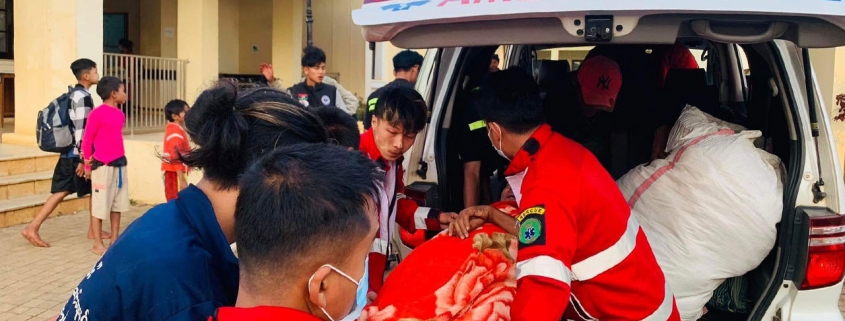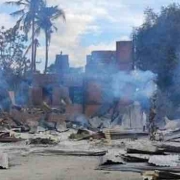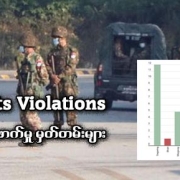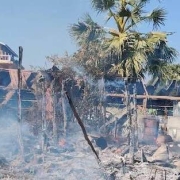Civilian deaths mount in Myanmar amid surge in junta airstrikes
At least 452 civilian deaths in Myanmar’s Shan and Kayah states since coup.
Civilian deaths are growing in Myanmar’s civil war amid a jump in airstrikes by the military junta, whose ground forces have faced stiff resistance from rebels and ordinary citizens who have taken up arms.
The military has killed at least 452 civilians in southern Shan and Kayah states in the 26 months since the February 2021 coup, rebel groups said Monday.
The latest death toll sheds new light on the situation in southeast Myanmar, where decades-long conflict between the military and ethnic armies has worsened since the junta began an offensive targeting People’s Defense Force paramilitaries and the armed groups that harbor them.
The airstrikes often target villages where PDF fighters are believed to be, killing civilians in the process. While the military denies targeting civilians, members of the opposition say the deaths are no accident and instead are a tactic used by the regime to wear down popular support for the rebels.
A new focus by the military on suppressing its adversaries in the southern Shan and Kayah state townships of Pinlaung, Pekon and Mongpai – also known as Moebye – has driven up the number of casualties in recent months, the Progressive Karenni People’s Force, or PKPF – a local offshoot of the PDF – announced Monday.
Since the coup, civilian casualties have steadily risen. At least 172 people were killed in the region in 2021, 248 in 2022, and 33 in the first quarter of 2023, said an official with the group, who spoke to RFA Burmese on condition of anonymity, citing security concerns.
The official said that while the military has targeted civilians throughout the conflict as part of a bid to undermine support for the armed resistance, the number of casualties has risen dramatically with its pivot to airstrikes.
“We saw a lot of civilian deaths due to small arms fire, artillery shelling and landmines in 2021 and 2022,” the official said. “But in 2023, the major cause of civilian deaths is junta shelling and airstrikes. The junta has been attacking non-military targets where civilians reside with artillery shelling and airstrikes, which we consider a serious war crime.”
Casualties mounting
The PKPF said that clashes in the region mostly occur between the military and a joint force of fighters from the ethnic Karenni Army and the Karenni National Defense Force.
Casualties on both sides “are mounting,” it said.
The group said that 41 members of the defense forces were killed in the fighting in 2021 and170 in 2022. As of the end of April, 48 defense soldiers have been killed in fighting this year, bringing to 259 the total number killed by the military since its coup.

An information officer with the KNDF, who also declined to be named, confirmed that more resistance fighters and civilians are being killed by airstrikes, which the military has increasingly come to rely on this year as anti-junta forces enjoy greater success on the ground.
“Whenever there is a clash on the ground, it is certain that the junta planes will come to that area to attack us,” said the officer, noting that prior to 2023, the military mostly deployed troops without air support.
The junta carried out only two airstrikes in Kayah and southern Shan states in 2021 compared to 182 in 2022 and 179 in the first four months of 2023 alone, according to the PKPF. Since the coup, the group said, the region has seen 663 battles that claimed the lives of nearly 2,000 junta troops – 448 in 2021, 1,115 in 2022, and 432 in 2023, as of the end of April.
RFA was unable to independently verify the PKPF’s claims. Attempts by RFA to contact the junta’s spokespersons for Shan and Kayah states went unanswered Monday.
Junta ‘bluntly violating’ code of war
Thein Tun Oo, executive director of the Thayninga Institute for Strategic Studies, which is made up of former military officers, dismissed the PKPF’s announcement as “propaganda.”
“It’s the nature of war that each side spreads propaganda,” he said. “For example, if an enemy soldier dies, they report three casualties for propaganda purposes … Since the other party is using this strategy a lot, we have to be very careful.”
However, the PKPF claimed that its data was collected “systematically” from the battleground.
In addition to the number of casualties since the coup, the PKPF also said that military airstrikes and shelling over the same period had destroyed 34 Christian and Buddhist religious buildings and 1,497 civilian buildings, including medical centers.
Banyar, director of the Karenni Human Rights Organization, said the number of destroyed buildings alone is proof of the junta’s war crimes.
“You are prohibited from attacking certain buildings, even during heated battles,” he said. “[Belligerents] need to minimize damage. There are codes that soldiers in battle must follow to avoid killing civilians and destroying their buildings, but the junta is bluntly violating all of them.”
Since the coup, conflict has forced some 200,000 people to flee their homes in Kayah and southern Shan states, most of whom endure brutal living conditions in the jungles of Demoso and Hpruso townships and are in urgent need of humanitarian assistance, according to aid workers.
Translated by Myo Min Aung. Edited by Joshua Lipes and Malcolm Foster.









